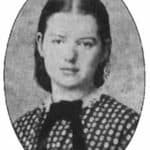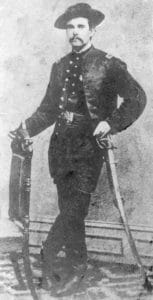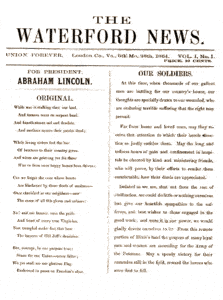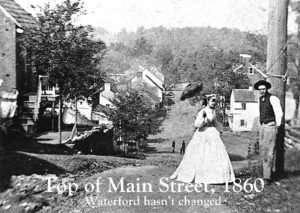ON THIS PAGE
Loudoun Quakers
The Peace
Bibliography
More:
The Women of Waterford
Three Women Journalists of the Civil War
by Meredith Bean McMath [more]
When Barbara Black was a very little girl, her grandfather would sit her upon his knee and tell her the story1:
On a road in the heart of Virginia, a handsome soldier in Confederate uniform approached a pretty young miss. The fellow's name was J. William Hutchinson, and he was actually a Union officer with the 13th New York Cavalry, but he was acting as a Scout in enemy territory. Soldiers weren't allowed out of uniform, but he needed to be mistaken for a Rebel soldier in order to gather information. So he became a turncoat, literally turning his blue cavalry jacket inside out to let the muslin lining be taken for Confederate homespun.
In this "disguise," Lieutenant Hutchinson approached the young lady and politely asked directions.
From there things took an interesting turn.
Although a Virginian, the girl was a Quaker from the town of Waterford, and she and her village were faithful to the Union cause. Her name was Lida Dutton, and, she was soon to become the editor of an underground newspaper
While it was against the tenets of Lida's faith to knowingly lie, it was against her nature to knowingly help a Confederate get where he was going any faster than he should. Her solution was to give the fellow directions only a local could understand: "Left at Brown's stump, right at Uncle Harmon's well, left at Zilpha's Rock..."
As the end of these impossible-to-follow instructions, Hutchinson quietly asked, "Miss, which side would you like for me to be on?"
She blurted, "If you're a Rebel, I hate you; if you're a Northerner, I love you!"
At that point, he was pleased to introduce himself as Lieutenant John William Hutchinson of the 13th New York Cavalry, followed by a presentation of the "lining" of his jacket: the brass buttons and navy wool of a Union officer.
Then he told her he planned to hold her to her promise.
In the first three years of the Civil War, Emma Eliza (known as Lida), sister Lizzie Dutton and cousin Sarah Steer cared for wounded Union soldiers2, hid them from marauding Rebel troops,3 and managed to hold together the farms and businesses their fathers and brothers had left behind in order to avoid being forced into the ranks of the Confederacy. But in the spring of 1864, these three stalwart young souls decided they could do more, and that nothing - not the lack of goods nor the abundance of Confederate soldiers - could thwart efforts.
By the spring of 1865, they'd written and published at least eight issues of The Waterford News, a newspaper for Union soldiers. In each edition's four, small pages the soldiers found a tidy sampling of patriotic editorials, poetry, riddles, local news and humor:
... The next day or two the rebels again visited this district and appropriated to their own use several horses and two wagons loaded with corn, belonging of course to Union citizens. They also visited the tannery of Asa M. Bond and arrested thirty-five dollars worth of leather.
WANTED: A few stores... with Dry-Goods, Molasses Candy and other stationery, suited to the tastes of the community. Young and handsome Clerks not objectionable.4
The Union soldiers ate it up.
The Waterford News, January 28, 1865: We are gratified to receive the repeated assurance from the soldiers, for whose amusement our little paper was intended, that our efforts have not proven unavailng, but that it is a welcome visitor to their camp.
In fact, some soldiers were so amused, they offered to leave the bachelor life on their behalf.
Not only did it boost morale, it brought in subscription fees - monies which the girls turned right around and sent back for soldiers' aid.5
| Wanted: A Union commander to take charge of the Rebel Conscripting Officers.Wanted: A straight-jacket for the Editor who was bent on having her own way.— The Waterford News, 11 Mo. 26th, 1864, Vol. I, No. 6 |
The Waterford News was even perused by President Lincoln. Private Schooley of the 11th Rgt., Maryland Volunteers sent a letter to the President with this introduction, "To His Excellency Abraham Lincoln. Will your excellency please accept the two enclosed copies of 'Waterford News' and excuse me for taking the liberty of sending them to you... You will see by the Sending, the intention of the Fair Editresses in editing the Paper under the difficulties which they do. 'Tis for to aid the 'Sanitary Commission.' They have already made up nearly 1000$ [sic] for the same purpose!"6
To understand the nature of these exceptional young women, we must understand their social context: the history of Quakers (also known as "The Religious Society of Friends") has been marked by unusual bravery and strength of character. Students of Quaker history find evidence of the persistent influence of a people of faith who helped change the course of American history, but evidence also shows the course of American politics influencing the nature of Quakerism.7 These competing influences are best exemplified in the history of Loudoun's Quakers - a people who found themselves struggling to maintain a pacifist tradition in the midst of Confederate Virginia.
Loudoun Quakers
By the early nineteenth century, most Loudoun Quakers associated themselves with the Hicksite faction of the church which espoused a more liberal point of view than Orthodox Quakers. By the time of the Civil War, they were still pacifists, met twice weekly for Meetings, disciplined their members, and encouraged plain dress, but further assumptions are destined to break down.8 They had been living in the middle of a heated political situation for several years, and their pacifism had been sorely tested. When John Brown's Raid occurred so near to Loudoun, local militias were formed. Quakers were told to show up for muster or pay a fine. At the beginning of the war, the Confederate army took Quakers for laborers or jailed them for use as bargaining chips. As a result, most headed north, but several men risked the discipline of the Quaker meeting and joined the Union Army.
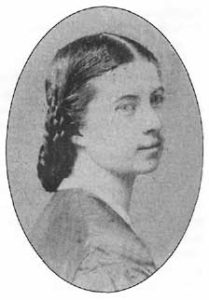
Lizzie Dutton
One of those men was young James Dutton, brother to Lida and Lizzie.9 By 1862, Lizzie had fallen in love and become engaged to a Lieutenant Holmes of the 7th Indiana Regiment. The matter had become personal, such that when it came to a choice of allegiance between country or faith, Quaker women like Lida, Lizzie and Sarah stubbornly chose to support both. A Waterford News editorial boldly stated, "Christians make the best soldiers."10
At every turn, Loudoun's Quaker women refused to be categorized. Regarding the tradition of Quaker "plain dress," for example, there is this interesting notation in the very first edition of The Waterford News: "Great distress is felt by the ladies of this vicinity at not being able to appear at meeting in new bonnets, dresses and wrappings, owing to the stringent blockade."11
These women were well educated and had been strongly encouraged to express themselves. Only a few years before the war, Lida, Lizzie and Sarah were active members of a Waterford Literary Society, writing essays whose topics ranged from a thoughtful, "What is There Left to Write About?" to a hilarious ode "On Chickens." Essays were read aloud to the group, gently critiqued by the members present, and then recorded in a large bound book. Thankfully, the Society's volumes survived the war and rest in the archives of The Thomas Balch Library of Leesburg, Virginia.12 One of the anonymous notes in the Society Essays reads, "Take life as it is, a real matter-of-fact thing, and do it justice." It's easy to imagine one of the "Fair Editresses" of The Waterford News penning that line.
Although the Literary Society provided a place for young ladies to sharpen their wits as well as their pencils, their excellent educations began at home. Several years before the war, Sarah Steer had been sent north to a Ladies Academy. In the Dutton home, Lida and Lizzie's parents, John and Emma, always encouraged their four daughters to exercise full use of their minds. In a letter written in 1864 to the youngest daughter, Anna Ellen, John wrote, "I take great pride in my childrens' writing. I want each to exert themselves in this particular branch of learning and now is the time whilst thy little fingers are limber... Make it a rule to study - to think - weigh thy thoughts well for thy self. Don't conclude things are right just because the mass of the people say so."13 As a result of such parenting and the Quakers' insistence on female education (all this, despite 19th century 'Woman as Shelf-Ornament' thinking), Lida, Lizzie and Sarah's writings are a treasure of womanly expression:
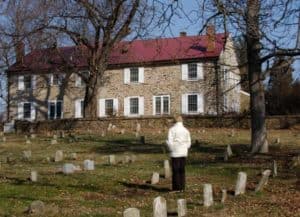
Waterford Meeting House of the Society of Friends. Used as a Confederate Headquarters at the very beginning of the conflict.
The young ladies of Waterford, Loudon [sic] Co., Va., are hereby notified to meet the first opportunity and lend their mutual aid in filling a large mud-hole with stone, said mud-hole being located in the middle of Second Street... the men have driven around it so much that it is extending each side. Being fearful the gentlemen will get their feet muddy, the ladies will try and remedy it.14
With no paper and no money, getting a newspaper out of Confederate Virginia was no small task. Draft copies of The Waterford News needed to be smuggled north across the Potomac River. The Baltimore American voluntarily printed the newspapers for them. Subscriptions were handled through the Federal Post Office at Point of Rocks, Maryland (the active Confederate troops made it impossible for the girls to distribute the paper from their homes). For their efforts, the young women risked severe "discipline" by the Confederate army, as did all of Waterford for its pro-Union sentiment.
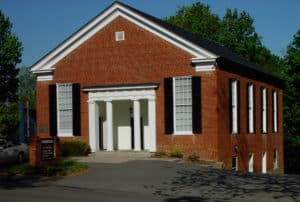
The Waterford Baptist Church, site of an August 1862 Confederate ambush of Union troops quartered there. The Union soldiers were members of the only Union troop ever formed in Virginia: The Independent Loudoun Rangers of Loudoun County
But Waterford's closest call occurred in 1862: Confederate troops arrived to forage and announced that, when they were through, they would burn the village down. Rachel Means, wife of Samuel Means of Waterford, ran to the only person she knew who still had a horse: a farmer just outside of town. She asked him to ride to Union General Geary, stationed just a few miles away, and tell him to send Union troops to save the town. The fellow flat-out refused. She then asked him to lend her his horse so she could make the ride. Again he told her "no." To that she replied, "Then I will steal thy horse and go myself." And so she did. General Geary promptly dispatched troops to the town, and Waterford was saved.15
With war literally at their doorstep, Lida, Lizzie and Sarah chose to publish the newspaper, despite personal risk, and even personal tragedy.
The July 2, 1864 edition of The Waterford News told its readers to press on:
Let not kind words, loving tones, and love of good deeds cease to find a place in our hearts. Now, if ever, is the time to 'cast bread upon the waters,' when tired and weary ones are all around us, and starvation stares so many in the face; when loved ones are struggling with pain, and joy and happiness are hidden in the distance; when hope leaves us and misery looks at us with hollow eyes. Let us be up and doing - old and young - we have no time to idle; every quickly flitting moment is to be improved, every space filled up.16
This editorial, which the modern reader might be tempted to dismiss as flowery patriotic sentiment, becomes poignantly descriptive when we discover it was written almost immediately after Lizzie received news that her fiancé, Lieutenant David Holmes, had been killed in the Battle of Petersburg.
In late November of 1864, General Grant authorized a raid on Loudoun County. This Union foray (a precursor to Sherman's March to the Sea) has become known in local lore as "The Burning Raid![]() ," but The Waterford News called it "The Fury Order." Grant's concept was to burn out the farms still able to provide forage to Confederate Colonel Mosby and his men. To this end, he ordered barns to be burned and livestock killed or driven off. Furthermore, men under 51 capable of bearing arms and any slaves remaining in the area were to be taken.
," but The Waterford News called it "The Fury Order." Grant's concept was to burn out the farms still able to provide forage to Confederate Colonel Mosby and his men. To this end, he ordered barns to be burned and livestock killed or driven off. Furthermore, men under 51 capable of bearing arms and any slaves remaining in the area were to be taken.
For the people of Loudoun who suffered from this order, political sentiment became unimportant. Mosby gathered forage from whoever had goods, thus the Union army visited whoever had goods.
So, in a sad twist of fate, pro-Union Loudouners had the unpleasant task of watching the Union army destroy in less than a week what they'd been hiding and protecting from bushwhackers and Confederates for four years. Between November 27th and December 2 of 1864, the skies over western Loudoun were dark with the smoke of hundreds upon hundreds of fires.17
But again Loudoun's Quaker women persevered. Major J.B. Wheeler of the 6th New York recorded that, "At Waterford, Loudoun County, Virginia, two young ladies perched on the wide gate posts in front of their home, waving American flags and said as their hay was being destroyed, 'Burn away, burn away, if it will keep Mosby from coming here.' "
Tradition holds that one of those young women was Lida Dutton.18
Not everyone was as stoic as Lida. When Union soldiers demanded matches from Quakeress Ruth Hannah Smith for the sole purpose of using them to burn down her barn, she quietly held the lucifers in the steam from her teakettle before handing them over. Her barn was saved.19
There is no doubt the soldiers were unhappy in their work. Briscoe Goodhart, who wrote an account of his years with the Independent Loudoun Rangers (the only Union troop ever formed in Virginia), mentions many successful and unsucessful adventures - but he skips the Loudoun Rangers' part in the burning raid completely.
Perhaps to assuage the soldiers' guilt, an editorial in the Jan. 28, 1865 edition of The Waterford News read:
We do not believe, if our Government had been as well acquainted with us as we are with ourselves, the order for the recent burning would be have been issued; but having suffered so much at the hands of the Rebels ever since the commencement of this cruel war, we will cheerfully submit to what we feel assured our Government thought a military necessity.
While Loudoun Quakers struggled to remain patriotic, the Burning Raid did have the intended affect on the Confederate populace: it broke the spirit of rebellion. By April the people were ready for peace.
The Peace
Thanks to a Confederate miller, we know exactly how Quakers celebrated the signing of the peace. Four days after Appamatox, Moses Pascal Watson wrote a short, bitter note and slipped it into the pages of his record book:
There is great rejoicing with the Union people in regard to the fall of Richmond and the surrender of General Lee. It is said Samuel M. Janney had the old gobbler killed and invited many of his Union friends to eat and be merry. William Tate shut himself up in a room and laughed his fill. Joseph Nichols has been riding, hunting hands to go to his house to drink cider get drunk and be merry. Bill Lemmon and Lot Tavener have gone fishing to day: they say the work is done. Thorton Witacer says the backbone of the Confederacy is broken and the war is about over. It is the prevailing opinion that the South can fight no longer.20
War hadn't altered Lida, Lizzie and Sarah's resolve, so it should come as no surprise that when peace came they kept right on doing life justice. While Lida and Lizzie continued to write editorials for local papers, Sarah Steer applied to the Freedmen's Bureau and the Philadelphia Meeting and to local Quakers for the funds to open a school for the children of freedmen.21 The school was built in 1867, the first of five in the County, but Sarah didn't wait for the walls to go up around her. She began teaching from her side yard in1865 and so became the "first teacher of black children" in Loudoun County.22
The school building, an historic property now known as "The Second Street School," is owned by The Waterford Foundation and is the site of a unique living history program. As part of Loudoun County's Public School curricula, children are able to spend a morning in the one-room school house, taking on the identities and responsibilities of the African-American children who attended in 1880.
An excellent summation of the trials and tribulations of Waterford Quakers is detailed in The Waterford Foundation publication, To Talk is Treason, by John Souders, Bronwen Souders and John Divine. Most of the story of Lida and Lizzie Dutton and Sarah Steer is contained therein. It is abundantly clear from their histories that any one of these women were capable of being that Editor referred to in the newspaper as "bent on having her own way."
As for Lizzie, there had been a fleeting correspondence between herself and a Lieut. James Dunlop of the 7th Indiana. Dunlop was a friend to her fallen fiancé and the very man who'd written her with news of his death. But, after the war, Lieut. Dunlop had gone home to Indiana to marry his childhood sweetheart.
Fate decreed Dunlop's wife would die within two years of the marriage. He never remarried. In 1881, he came to Washington on business and used the excuse to send a card out to the Dutton home.
When he received a pleasant reply from "Miss Lizzie Dutton," he took the next train out of Washington to Waterford.
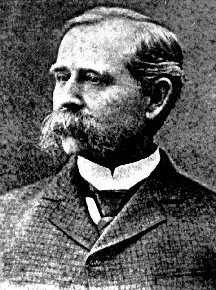
James Dunlop (post-war photograph courtesy of descendants and The Waterford Foundation)
A newspaper account of the event reads that as the two renewed their acquaintance, "...matters flowed on so easily, smoothly, and naturally, that in a few weeks Mr. Dunlop found himself at his Indiana home busily engaged in preparing for the reception of a new mistress, and soon the little town of Waterford was all a blaze of light and a scene of general rejoicing, for the lady was popular and beloved by all." Joseph Dunlop and Lizzie Dutton were married on January 22, 1882.23
Last, but not in the least least, there was the story of Lida and that Union Lieutenant.
When young Barbara Black was on her grandpa's knee listening to the tale, there would always come a point where her grandmother would interrupt the telling. That part about the promise. When her Grandfather would say Lida promised that Union Lieutenant she'd love him if he were a Northerner, her grandmother, often blushing, would protest in her soft Virginia drawl that she'd said like and not love.
Despite this, in the dozen times Barbara heard the story, her grandfather, John William Hutchinson, never felt the need to change the facts of how he met his Quaker bride. He also never felt the need to hold his grand-daughter with both hands; his other hand would almost always be holding Lida's.
Like him or love him, when William came back for her after the war, she married him. He joined the Quaker church and moved his bride north to New York where they continued to hold that cheerful argument in front of their children, then their grandchildren, and, eventually, their great-grandchildren. William and Lida were man and wife for 53 years before he passed away.24
Heroes are created when people choose to do life justice in the midst of crisis. Thanks to the preservation of women's history, we're able to celebrate the heart of three amazing heroes - editors Sarah, Lizzie and Lida who were happily bent on having their own way.
Many threats have been made about burning our houses over our devoted heads.
But Waterford is still standing. And we trust it may stand long in the future
to remind other generations that in its time-honored walls once dwelt as true lovers of their country as ever breathed the breath of life-long-suffering - but stood faithful to the end.
- The Waterford News, July 2, 1864
Bibliography
[1] Letter of Barbara Dutton Conrow Black to Ladies Home Journal dated Feb. 4, 1962 (copy in Waterford Foundation Archives, Waterford, VA)
[2] Waterford Perspectives, Education Committee of The Waterford Foundation, Waterford Foundation Archives
[3] To Talk is Treason, Bronwen and John Souders and John Divine, The Waterford Foundation, Waterford, VA (1997) p. 56
[4] The Waterford News, Vol. 1, No.'s 1-8 (copies in "Civil War File" of The Thomas Balch Library, Leesburg, VA and The Waterford Foundation Archives)
[5] ibid, Vol. I, No. 2 (Nov. 6, 1864)
[6] "Robert Todd Lincoln" papers, Manuscript Division, Library of Congress (referred to in Oct. 6, 1955 article from The Blue Ridge Herald, "Lincoln Papers Reveal Waterford Had Newspaper During Civil War;" copy in "Civil War File," Thomas Balch Library).
[7] To Talk is Treason, et al
[8] The Transformation of American Quakerism, by Thomas D. Hamm, Indiana Univ. Press (1988), p. 52
[9] "Girls Published Civil War Newspaper," by Emma H. Conrow, Baltimore American newspaper, February 5 1922, p. C-3 (copy in "Civil War File" at the Thomas Balch Library and The Waterford Foundation archives).
[10] The Waterford News, Vol. I, No. 6 (Nov. 26, 1864)
[11] ibid, Vol. I, No.1 (May 28, 1864)
[12] Essays of Friends Literary Society, Waterford, 1857-60, Rare Manuscripts - Thomas Balch Library, Leesburg, VA
[13] To Talk is Treason, p. 87
[14] The Waterford News, Vol. I, No. 1 (May 28, 1864)
[15] Waterford Perspectives, Thomas Balch Library, Leesburg, Virginia
[16] The Waterford News, Vol. I, No. 3 (July 2, 1864)
[17] Hillsboro: Memories of a Mill Town, Hillsboro Bicentennial History Committee, Pub'd by the Hillsboro Community Association, p. 25 (The Thomas Balch Library)
[18] To Talk is Treason, p. 92
[19] Ye Meetg Hous Smal, Werner and Asa Moore Janney published by Werner and Asa Moore Janney (The Thomas Balch Library) p. 42 - insert
[20] Ye Meetg Hous Smal, Werner and Asa Moore Janney published by Werner and Asa Moore Janney (The Thomas Balch Library)
[21] Friends Intelligencer, vol. XX, pp 250-251 (copies in Waterford Foundation Archives)
[22] The County of Loudoun, by Nan Donnelly-Shay and Griffin Shay, The Donning Co. (1988) p. 53
[23] Camp & Field, Sketches of Army Life, by Wilbur F. Hinman (Cleveland, 1892) (Ref., The Thomas Balch Library) pp 422-423
[24] "Commonplace Book" by Mary Frances Dutton Steer (collection of letters and memoirs), Waterford Foundation Archives, p. 15
About the Author
Meredith Bean McMath is an award-winning historian, prize-winning playwright, author of historic fiction, and the Director of Run Rabbit Run Productions, Inc. Her living history programs have been produced for schools, libraries and museums which include The Smithonsonian Institution's National Museum of American History, The Newseum, Oatlands Plantation and the Museum of the Shenandovah Valley, and Run Rabbit Run documentaries have appeared on The History Channel and in Virginia classrooms. McMath holds a B.A. in History from the College of William and Mary and an M.S. in Arts Administration from Shenandoah University. Contact McMath at Meredith.McMath@gmail. com or visit her website at www.MeredithBeanMath.com.
